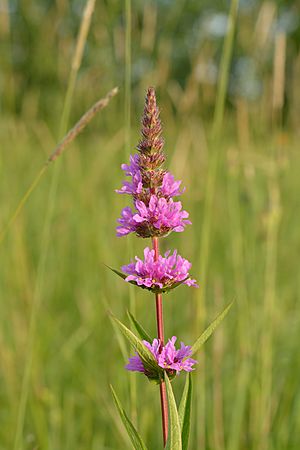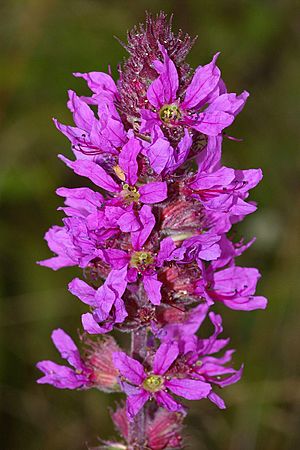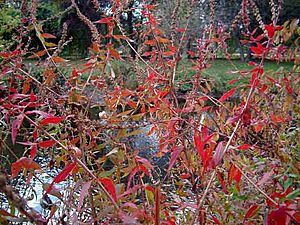Lythrum salicaria facts for kids
Quick facts for kids Lythrum salicaria |
|
|---|---|
 |
|
| Conservation status | |
| Scientific classification | |
| Genus: |
Lythrum
|
| Species: |
salicaria
|
The Lythrum salicaria is also known as purple loosestrife. It is a beautiful flowering plant that belongs to the plant family Lythraceae. Don't confuse it with other plants called "loosestrife" that are in a different family called Primulaceae. Some other names for this plant are spiked loosestrife and purple Lythrum.
Contents
What is Purple Loosestrife?
Purple loosestrife is a herbaceous perennial plant. This means it's a plant that has soft stems (not woody like a tree) and lives for more than two years. It can grow quite tall, usually 1 to 2 meters (about 3 to 6 feet) high. It often forms large groups of plants, sometimes 1.5 meters (5 feet) or more wide. Many straight stems grow up from one strong, woody root system.
The stems of the plant are reddish-purple or red to purple. They are also square-shaped if you look at them from the top. The leaves are long and narrow, like a spearhead. They are usually 3 to 10 centimeters (1 to 4 inches) long and 5 to 15 millimeters (about 0.2 to 0.6 inches) wide. They feel a bit soft and fuzzy, and they attach directly to the stem without a stalk. The leaves grow in pairs opposite each other, or sometimes in groups of three around the stem.
Flowers and Seeds
The flowers of the purple loosestrife are a pretty reddish-purple color. Each flower is about 10 to 20 millimeters (0.4 to 0.8 inches) across. They usually have six petals, but sometimes five. Inside, they have 12 stamens (the parts that make pollen). These flowers grow in tight bunches where the leaves meet the stem.
Purple loosestrife flowers are special because they have three different types! These types have stamens and styles (parts of the flower) of different lengths: short, medium, or long. A flower of one type can only be pollinated by a flower of a different type. This helps make sure that different plants share their pollen, which is called cross-pollination. Many kinds of insects visit these flowers to help with pollination.
After the flowers bloom, the plant produces small fruits. Each fruit is a tiny capsule, only 3 to 4 millimeters (about 0.1 to 0.2 inches) long. Inside, it holds many very tiny seeds. The plant flowers all summer long. In early autumn, when the seeds are ready, the leaves often turn a bright red color. This red color can last for almost two weeks. The old, dead stems from the year before turn brown.
Where Purple Loosestrife Lives
Purple loosestrife is originally from Europe, Asia, northwest Africa, and southeastern Australia.
Habitat
You can find this plant in wet places like ditches, damp meadows, and marshes. It also grows along the edges of lakes.
Insects That Visit Purple Loosestrife
Long-tongued insects like bees and butterflies are important for pollinating the flowers. They help the plant make seeds.
Many different insects also use purple loosestrife as a source of food.
- The black-margined loosestrife beetle (Galerucella calmariensis) is a brown beetle with a black line on its back. Adult beetles eat the leaves, making round holes. Their young, called larvae, eat the tender leaf buds and strip the tissue from the leaves.
- The golden loosestrife beetle (Galerucella pusilla) looks very much like the black-margined beetle, but it usually doesn't have the black line. It eats the plant in a similar way.
- The loosestrife root weevil (Hylobius transversovittatus) is a large, red weevil that is active at night. It eats leaves and leaf buds. Its larvae hatch from eggs and immediately dig into the plant's roots. They feed on the roots for more than a year. This root damage can stop the plant from growing well and making seeds. If many larvae are in one root, they can even kill the plant.
- The loosestrife flower weevil (Nanophyes marmoratus) is a tiny weevil. It lays one egg in each flower. When the larvae hatch, they eat the parts of the flower that would make seeds. This stops the plant from producing any seeds. The larvae often hollow out the flower buds and use them as safe places to grow into adult weevils.
The Caterpillars of the engrailed moth (Ectropis crepuscularia) also eat purple loosestrife. This moth eats many different types of plants.
Uses and Impact
Purple loosestrife has been used in traditional medicine to help with problems like diarrhea and dysentery (upset stomach). It is thought to be safe for people of all ages, even babies.
People also grow purple loosestrife as an ornamental plant in gardens. It's especially good for wet, poorly drained places like marshes or next to water. However, it can also grow in drier conditions. The flowers are very colorful and attractive. Gardeners have chosen different types of purple loosestrife for their flower colors, including:
- 'Atropurpureum' has dark purple flowers.
- 'Brightness' has deep pink flowers.
- 'Happy' has red flowers on a short stem (about 60 cm or 2 feet tall).
- 'Purple Spires' has purple flowers on a tall stem.
- 'Roseum Superbum' has large pink flowers.
Two types, ‘Blush’ (with blush-pink flowers) and 'Feuerkerze' (with rose-red flowers), have even won an award from the Royal Horticultural Society called the Award of Garden Merit.
Beekeepers have also brought purple loosestrife to many parts of North America. This is because the plant has so many flowers that provide a lot of nectar for bees.

Purple Loosestrife as an Invasive Species
Purple loosestrife has been introduced to places like New Zealand and North America. In these areas, it has become widely naturalized, meaning it grows freely as if it were native. In some places, it is even officially listed as a plant that needs to be controlled.
When purple loosestrife grows too much, it can cause big problems. It can block the flow of water in rivers and canals. It also causes a sharp drop in biological diversity. This means that native plants that animals rely on for food and shelter, like cattails, get completely pushed out. This affects many living things, from waterfowl to amphibians and even tiny algae.
A single purple loosestrife plant can make up to 2.7 million tiny seeds each year! These seeds are easily carried by wind and water. They can sprout in wet soil after staying dormant through the winter. The plant can also grow new shoots from pieces of its roots left in the soil or water. Once purple loosestrife starts to grow in an area, it is very hard and expensive to remove it using machines or chemicals.
Plants sold as "European wand loosestrife" (L. virgatum) are actually the same species. Sometimes, the plants sold are sterile, which means they cannot make seeds. This is better because it prevents them from spreading.
In North America, you can tell purple loosestrife apart from similar native plants like fireweed, blue vervain, Liatris species, and spiraea (Spiraea douglasii). Purple loosestrife has square-shaped stems. Its leaves grow in pairs that are at right angles to each other, and they do not have jagged edges.
Controlling Purple Loosestrife with Insects
Purple loosestrife is a great example of how biological pest control can work well. Biological control means using natural enemies, like insects, to manage a pest plant. Scientists started researching this in 1985. Today, purple loosestrife is managed well using several insects that eat it.
Five types of beetles naturally feed on purple loosestrife and can cause a lot of damage to the plant. These beetles are used to help control the plant:
- Two types of leaf beetle: Galerucella calmariensis and Galerucella pusilla.
- Three types of weevil: Hylobius transversovittatus, Nanophyes breves, and Nanophyes marmoratus.
When either of the Galerucella beetle species infest an area, they are very good at getting rid of purple loosestrife. They can eat almost all the leaves (up to 100%) off the plants in an area. The moth Ectropis crepuscularia is not used for biological control because it eats many different plants and can itself be a pest.
Images for kids
See also
 In Spanish: Arroyuella para niños
In Spanish: Arroyuella para niños






